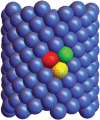Zig-zag twins and helical phase transformations
- PMID: 27002072
- PMCID: PMC4810885
- DOI: 10.1098/rsta.2015.0208
Zig-zag twins and helical phase transformations
Abstract
We demonstrate the large bending deformation induced by an array of permanent magnets (applied field ∼0.02 T) designed to minimize poles in the bent state of the crystal. Planar cantilevers of NiMnGa (5M modulated martensite) ferromagnetic shape memory alloy deform into an arched shape according to theory, with a zig-zag microstructure that complies with the kinematic and magnetic compatibility between adjacent twin variants. A general theory of bent and twisted states is given, applicable to both twinning and austenite/martensite transformations. Some of these configurations achieve order-of-magnitude amplification of rotation and axial strain. We investigate also atomistic analogues of these bent and twisted configurations with perfect interfaces between phases. These mechanisms of large deformation, induced by small magnetic fields or temperature changes, have potential application to the development of new actuation technologies for micro-robotic systems.
Keywords: Ni2MnGa; bending; continuum mechanics; ferromagnetic shape memory; martensitic phase transformation.
© 2016 The Author(s).
Figures








References
-
- James R, Zhang Z. 2005. A way to search for multiferroic materials with unlikely combinations of physical properties. In Magnetism and structure in functional materials, vol. 9 (eds A Planes, L Manõsa, A Saxena), pp. 159–175. Springer Series in Materials Science. Berlin, Germany: Springer.
-
- Cui J, Wu Y, Muehlbauer J, Hwang Y, Radermacher R, Fackler S, Wuttig M, Takeuchi I. 2012. Demonstration of high efficiency elastocaloric cooling with large ΔT using NiTi wires. Appl. Phys. Lett. 101, 073904 (10.1063/1.4746257) - DOI
-
- Song Y, Bhatti K, Srinivasan V, Leighton C, James RD. 2013. Thermodynamics of energy conversion via first order phase transformation in low hysteresis magnetic materials. Energy Environ. Sci. 6, 1315 (10.1039/c3ee24021e) - DOI
-
- Srivastava KBV, Song Y, James RD. 2011. The direct conversion of heat to electricity using multiferroic alloys. Adv. Energy Mater. 1, 97–104. (10.1002/aenm.201000048) - DOI
Publication types
LinkOut - more resources
Full Text Sources
Other Literature Sources
Miscellaneous

